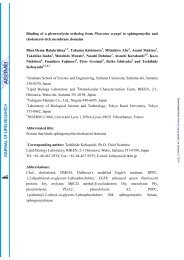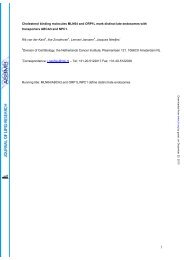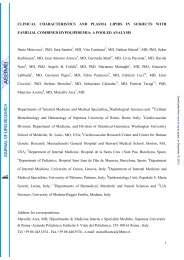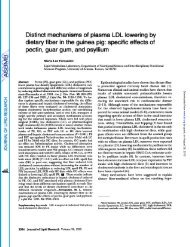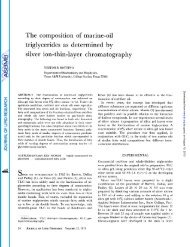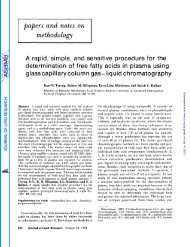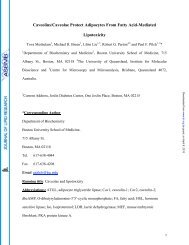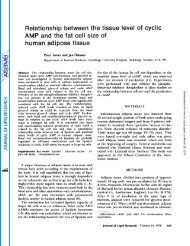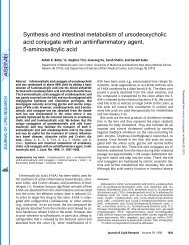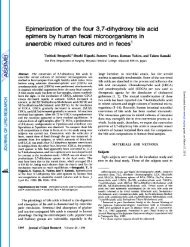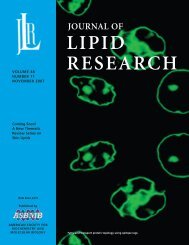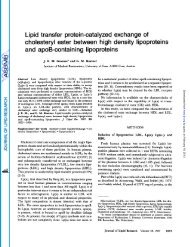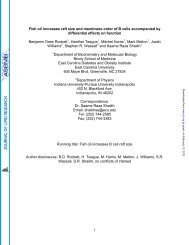Cholesterol gallstone dissolution in bile - The Journal of Lipid ...
Cholesterol gallstone dissolution in bile - The Journal of Lipid ...
Cholesterol gallstone dissolution in bile - The Journal of Lipid ...
Create successful ePaper yourself
Turn your PDF publications into a flip-book with our unique Google optimized e-Paper software.
Whereas reversal <strong>of</strong> deposited cholesterol <strong>in</strong> the <strong>of</strong> specific activity <strong>of</strong> 1 mCi (CDC studies) or 5 mCi<br />
arterial <strong>in</strong>tima is not yet a practical therapeutic meas- (UDC studies) per 5 g. After short-term storage at<br />
ure, considerable success has been achieved <strong>in</strong> recent -20°C under NP, the samples were chemically and<br />
years <strong>in</strong> dissolv<strong>in</strong>g cholesterol <strong>gallstone</strong>s <strong>in</strong> the gall- radiochemically pure by gas-liquid chromatography<br />
bladder and <strong>bile</strong> ducts by medical means. <strong>The</strong> <strong>in</strong>- (GLC) and th<strong>in</strong>-layer chromatography (TLC) with<br />
gestion <strong>of</strong> two specific <strong>bile</strong> acids, chenodeoxycholic zonal scann<strong>in</strong>g. Crystall<strong>in</strong>e unconjugated CDC and<br />
(3a,7a-dihydroxy-5/3-cholanoic, CDC) acid or its 7p- UDC acids <strong>of</strong> ~99% purity (TLC, GLC) were genhydroxy<br />
epimer, ursodeoxycholic (Sa,7P-dihydroxy- erously supplied by Dr. Herbert Falk (Dr. Falk GmbH<br />
5/3-cholanoic, UDC) acid, decreases cholesterol secre- 8c Co., Freiburg, West Germany) and were converted<br />
tion <strong>in</strong>to <strong>bile</strong> (5), desaturates <strong>bile</strong> with cholesterol to the sodium salts as described (9). <strong>The</strong> glyc<strong>in</strong>e<br />
(5), and <strong>in</strong>duces slow <strong>dissolution</strong> <strong>of</strong> <strong>gallstone</strong>s <strong>in</strong> about (G) conjugates <strong>of</strong> similar purity were generously<br />
a quarter to a third <strong>of</strong> patients (6).<br />
custom-synthesized by the 'Tokyo Tanabe Pharma-<br />
S<strong>in</strong>ce a detailed understand<strong>in</strong>g <strong>of</strong> the <strong>dissolution</strong> ceutical Co. (Tokyo, Japan) and were supplied as<br />
k<strong>in</strong>etics <strong>of</strong> cholesterol from biological precipitates is sodium salts. <strong>The</strong> taur<strong>in</strong>e ('I) conjugates were pur<strong>of</strong><br />
considerable theoretical as well as therapeutic chased from Calbiochem (San Diego, CA) and were<br />
importance, the aims <strong>of</strong> the present study are: i) to generally about 98% pure by TLC and high peridentify<br />
quantitatively the k<strong>in</strong>etic factors which control formance liquid chromatography (HPLC) employ<strong>in</strong>g<br />
the <strong>dissolution</strong> rates <strong>of</strong> <strong>gallstone</strong>s with both CDC an octadecylsilane reversed phase column. One-perand<br />
UDC, especially s<strong>in</strong>ce these <strong>bile</strong> acids differ cent solutions <strong>of</strong> both ?' conjugates were potentiomarkedly<br />
<strong>in</strong> their cholesterol solubiliz<strong>in</strong>g capacities metrically titrated with 2 N HCl and when a correct<br />
(7), ii) to compare the <strong>dissolution</strong> k<strong>in</strong>etics <strong>of</strong> choles- titration curve was not obta<strong>in</strong>ed the sample was reterol<br />
monohydrate (ChM) with anhydrous cholesterol crystallized prior to study (9, 10). Samples <strong>of</strong> other<br />
(Ch.4) (8) (even though the latter is not found <strong>in</strong> common <strong>bile</strong> salts, cholate (C), deoxycholate (DC),<br />
<strong>gallstone</strong>s, it may well be the chemical form <strong>of</strong> choles- and their T and G conjugates (Calbiochem, San<br />
terol <strong>in</strong> biological membranes and <strong>in</strong> the <strong>in</strong>terior <strong>of</strong> Diego, C.4) were <strong>of</strong> similar purity (TLC, HPLC) after<br />
other macromolecular lipid aggregates),' and iii) to recrystallization (9). Benzoic acid was obta<strong>in</strong>ed from<br />
identify and evaluate possible physical-chemical Fisher Scientific (Boston, MA) and was ~99.8% pure<br />
factors which might accelerate or retard <strong>gallstone</strong> by elemental analysis. ,411 other chemicals were<br />
disso1utic)n <strong>in</strong> vivo.<br />
A.C.S. and/or reagent grade. Roasted NaCl (600"C),<br />
We establish that <strong>dissolution</strong> rates and maximum carbonate-bicarbonate or phosphate buffers, ionmicellar<br />
solubilities <strong>of</strong> ChA are significantly greater exchanged, filtered and glass-distilled water, and acidthan<br />
ChM irrespective <strong>of</strong> the <strong>bile</strong> salt species. ChA alkali-washed Pyrex-brand glassware were used<br />
and ChM <strong>dissolution</strong> is much faster <strong>in</strong> solutions <strong>of</strong> throughout (9, IO).<br />
CDC and its conjugates than <strong>in</strong> solutions <strong>of</strong> UDC<br />
and its con-jugates, and <strong>in</strong> each case the <strong>dissolution</strong> Methods<br />
k<strong>in</strong>etics are non-diffusion controlled. Thus 'stone" the ,4nhydrous cholesterol (ChA). Five g <strong>of</strong> recrystallized<br />
solution <strong>in</strong>terfacial reaction is rate-limit<strong>in</strong>g for gall- [ 1, 2:3H]cholesterol was dissolved <strong>in</strong> hot (70°C)<br />
stone <strong>dissolution</strong> by <strong>bile</strong> salts and this reaction is MeOH (350 ml) and the solution was cooled quickly<br />
slower for ChM than for ChA. <strong>The</strong>se data suggest<br />
to 4°C. <strong>The</strong> precipitated crystals were filtered through<br />
that with our present <strong>in</strong>ability to shake the gallbladder a 10- 1.5 mesh autoclaved fritted glass filter <strong>in</strong> a<br />
mechanically <strong>in</strong> situ the prospects for accelerat<strong>in</strong>g Buchner Funnel (Fisher Scientific, Boston, MA)<br />
<strong>gallstone</strong> <strong>dissolution</strong> by chemical means are not good. and the MeOH was evaporated overnight <strong>in</strong> vacuo<br />
at 80°C:. <strong>The</strong> dry crystals were then stored <strong>in</strong> a darkened<br />
dessicator for short periods <strong>of</strong> time over CaSO,.<br />
EXPERIMENTAL PROCEDURE<br />
<strong>Cholesterol</strong> monohydrate (ChM). Five g <strong>of</strong> recrystallized<br />
[ 1. P-'H]cholesterol was dissolved <strong>in</strong> 95% EtOH (400<br />
Materials<br />
ml) at 60°C. <strong>The</strong> solution was slowb cooled to room<br />
<strong>Cholesterol</strong> (Nu-Chek Prep, Aust<strong>in</strong>, MN) was recrystallized<br />
thrice from hot 95% EtOH and mixed<br />
with [I, 2-'H]cholesterol (New England Nuclear Co.,<br />
Boston, MA) to provide, as required, =5 gram batches<br />
temperature (43°C) and then seeded with a f-ew<br />
crystals <strong>of</strong> pure ChM (1 1). By 48 hours, a generous<br />
crop <strong>of</strong> ChM crystals had precipitated from the<br />
mother liquor and these were harvested by filtration<br />
as described above and then dried o\zernight <strong>in</strong> a<br />
' Mazer., N. A,, C;.<br />
tor. publication.<br />
B. Renedek, and M. C. Carey. Submitted dessicator therrnostatted at<br />
stored for brief periods at<br />
40°C. 'l'he crystals were<br />
23°C <strong>in</strong> a darkened des-<br />
Ipmi o7zd Cay K<strong>in</strong>etics <strong>of</strong> cholesterol <strong>gallstone</strong> <strong>dissolution</strong> 255<br />
Downloaded from<br />
www.jlr.org by guest, on June 9, 2013



